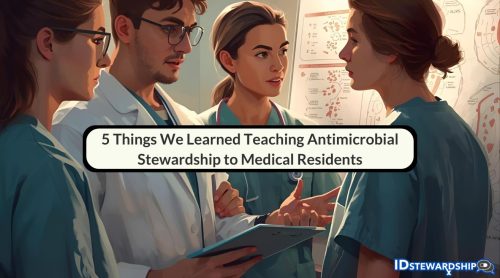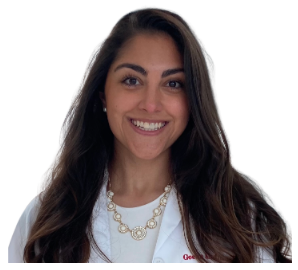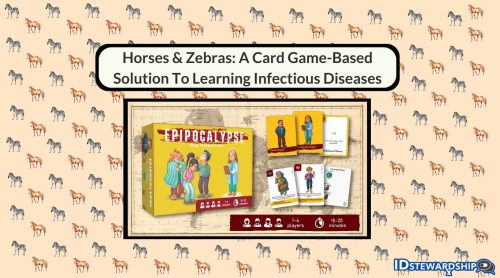AI-Generated Summary
This interview explores how Dr. Hanretty and Dr. Kludjian are teaching antimicrobial stewardship to medical residents, blending case-based learning, interactive tools, and real-world application. Their insights highlight effective strategies for teaching stewardship principles, engaging learners, and adapting medical education in the era of artificial intelligence.


Interview with: Alexandra Hanretty, Pharm.D. & Geena Kludjian, Pharm.D., BCIDP

Interview by: Timothy P. Gauthier, Pharm.D., BCPS, BCIDP
Article posted 12 October 2025
Scientific conferences offer a unique blend of discovery, collaboration, and inspiration — places where new research sparks conversation and professional connections grow into enduring collaborations. During the recent ESCMID Global conference, I had the pleasure of meeting Dr. Hanretty and Dr. Kludjian as they presented a poster on antimicrobial stewardship and medical education. Their passion for improving how we teach and practice stewardship immediately stood out.
After the conference, I reached out to learn more about their work and was thrilled when they agreed to an interview for the IDstewardship blog. Over the following six months, we corresponded to explore how their institution integrates stewardship principles into residency training — a topic that continues to gain importance as we prepare the next generation of clinicians to use antibiotics wisely.
If you are involved in teaching antimicrobial stewardship to medical residents or other learners, this conversation offers practical insights and creative ideas for engaging them.
1. Can you describe how you got into your current roles and began working with medical residents on antimicrobial stewardship?
At our institution, the inpatient hospital Antimicrobial Stewardship Program (ASP) consists of two full-time infectious diseases (ID) trained clinical pharmacy specialists and ID trained physicians. Antimicrobial Stewardship rotations were established as a mandatory component of the ID fellowship program in 2017, and in 2018 it was expanded to be offered as an elective rotation for Internal Medicine (IM) residents.
The IM residency is a single-hospital, university-based program which includes 82 residents. Since 2018, our ASP has had over 100 residents rotate through and from the 2022 through 2025 academic year our program had 95 IM rotators. While ASP electives are common for ID fellows and pharmacy residents, an elective for IM residents is less common. Since IM residents account for most antibiotic orders, incorporating stewardship concepts into their education through a formalized elective “makes sense”.
As the elective has gained popularity amongst the residents we have dedicated most of our experiential education efforts to contributing to IM residency training. This not only fosters a collaborative environment throughout the institution, but it also facilitates a professional relationship as residents move into fellowship or hospitalist roles.
2. Why has the antimicrobial stewardship rotation for medical residents gained popularity?
A key element contributing to rotation success is the engaging, yet low-stress learning environment.
Residents are typically assigned 6-8 patients to work-up for rounds. We select patients that have practical stewardship interventions that they can replicate in clinical practice. We also tailor patients based on the residents’ interests. For example, if they are interested in oncology, we will try to select some oncology patients and incorporate relevant literature throughout the week. The patient selection and light case load allow more time for them to focus on reviewing relevant literature and review guidelines that can be applied to their daily practice. The residents appreciate learning about updated guidelines and evolving recommendations, especially when these differ from what they were taught in medical school or from approaches that are still commonly done in clinical practice.
Based on the feedback from our rotation survey, residents value the case-based learning approach, particularly the opportunity to review stewardship patients concurrently with topics such as treatment of complicated UTIs, AmpC and ESBL producing organisms, bug-drug nuances, and gram-negative bacteremia.
Another engaging strategy we incorporate is Empiric, a clinical card game that reinforces antimicrobial selection through interactive, case-based play. It promotes discussion, sharpens decision-making, and brings a fun, dynamic element to the rotation.
We honestly have the residents themselves to thank for the gain in popularity of the rotation, as sharing their positive experiences with co-residents has been key in encouraging others to take it.
3. What are some antibiotic topics that medical residents struggle with the most?
One of the most common challenges medical residents have is the interpretation of susceptibility results, especially with gram-negative resistance. This is a very dense topic, and when we used to teach it in more of a didactic fashion or have residents read an article on specific types of resistance (e.g., AmpC) they still had a hard time understanding it.
We have found that residents often benefit from breaking these concepts down into quick, digestible “5-minute” discussions during rounds and connected to patient cases. For example, we assign them a patient with ESBL bacteremia, discuss ESBL resistance and treatment during rounds, and will send them the Merino trial to read post-rounds. We also like to sketch out simplified visuals or charts to aid in learning the concepts. With more layered topics like gram-negative resistance, we typically tailor the depth of discussion to the resident’s level and specific interests. For example, we’ll focus on practical concepts they are likely to encounter in daily practice like treatment of AmpC and ESBL producers, while sometimes avoiding deeper dives into carbapenemases or other organisms and resistance mechanisms unless the learner expresses a specific interest.
At the end of the week, we like to use the card game Empiric to round out the nuances on “bug-drug” selection. Using med-ed games works best if we have two residents with us so that they are also competing against each other. This works as a good summation of the week for drug-bug selection and to review differences in antibiotics.
4. How is access to artificial intelligence affecting how you teach and how your residents learn?
With the different artificial intelligence (AI) tools available, we are seeing a wide spectrum of usage.
Some residents have mentioned using AI tools like OpenEvidence to explore differential diagnoses and treatment options, while others have used it to summarize the articles or to prepare their topic discussion. In the latter, we worry it could negatively affect the residents’ learning, as they are only getting key points of the article, rather than coming to their own conclusions. Using AI as a supplement to something like Up to Date, or our internal application, Firstline, has been more beneficial in our opinion.
Most importantly, we still encourage them to research topics independently or review specific articles we provide rather than just jumping to AI. In the current state, AI feels more like a supplemental tool rather than something the residents rely on as an “end all, be all” which we think is appropriate in this setting.
With the new generation of learners, we have found that some concepts we used to teach effectively now require different approaches. It would be interesting to see if in the future AI could help develop creative, individualized teaching strategies that can be adapted to each learner’s needs.
5. As you look to the future, what are you most excited in the evolution of your antimicrobial stewardship medical resident rotation?
As we look to the future of our antimicrobial stewardship elective for internal medicine residents, we’re most excited to continue the momentum we’ve built.
What started as an opportunity to introduce residents to stewardship principles has evolved into a highly sought-after rotation that fosters meaningful discussion, curiosity, and collaboration. We’ve been encouraged by the enthusiasm of residents who leave the week with a deeper appreciation for the complexities of antimicrobial decision-making and the broader impact of stewardship on patient care and public health.
At this stage, we’re most proud of where the rotation stands and the consistency of the learning experience it provides. Our focus is on maintaining its quality, ensuring residents continue to feel engaged, and preserving the interactive, case-based approach that makes it valuable.
We’re also exploring ways to formally measure the elective’s long-term impact on prescribing behaviors and stewardship engagement after residency. This will help us refine the curriculum and advocate for broader integration of stewardship education across training programs.
Finally, we’re looking forward to sharing our experience and learning from others who are developing similar curricula. Seeing the enthusiasm from residents reaffirmed that stewardship education can be both practical and inspiring—an investment in the future of thoughtful antimicrobial use.
ABOUT THE INTERVIEWEES
 Geena Kludjian, Pharm.D., BCIDP is an infectious diseases clinical pharmacy specialist at Cooper University Hospital in Camden, New Jersey. She received her Doctorate of Pharmacy from Philadelphia College of Pharmacy. She completed pharmacy practice residency at Temple University Hospital and infectious diseases residency at Temple University School of Pharmacy. Some of her areas of interest include teaching, antimicrobial and diagnostic stewardship, treatment of resistant gram-negative infections, and management of patients with antibiotic allergies.
Geena Kludjian, Pharm.D., BCIDP is an infectious diseases clinical pharmacy specialist at Cooper University Hospital in Camden, New Jersey. She received her Doctorate of Pharmacy from Philadelphia College of Pharmacy. She completed pharmacy practice residency at Temple University Hospital and infectious diseases residency at Temple University School of Pharmacy. Some of her areas of interest include teaching, antimicrobial and diagnostic stewardship, treatment of resistant gram-negative infections, and management of patients with antibiotic allergies.
 Alexandra Hanretty, Pharm.D., is an infectious diseases clinical pharmacy specialist at Cooper University Hospital in Camden, New Jersey. She received her Doctor of Pharmacy from Temple University School of Pharmacy. She completed pharmacy practice residency at University of California, San Francisco and infectious diseases residency at Temple University. Some of her areas of interest include antimicrobial and diagnostic stewardship, treatment of resistant gram-negative infections, and infection prevention.
Alexandra Hanretty, Pharm.D., is an infectious diseases clinical pharmacy specialist at Cooper University Hospital in Camden, New Jersey. She received her Doctor of Pharmacy from Temple University School of Pharmacy. She completed pharmacy practice residency at University of California, San Francisco and infectious diseases residency at Temple University. Some of her areas of interest include antimicrobial and diagnostic stewardship, treatment of resistant gram-negative infections, and infection prevention.
RECOMMENDED TO YOU


